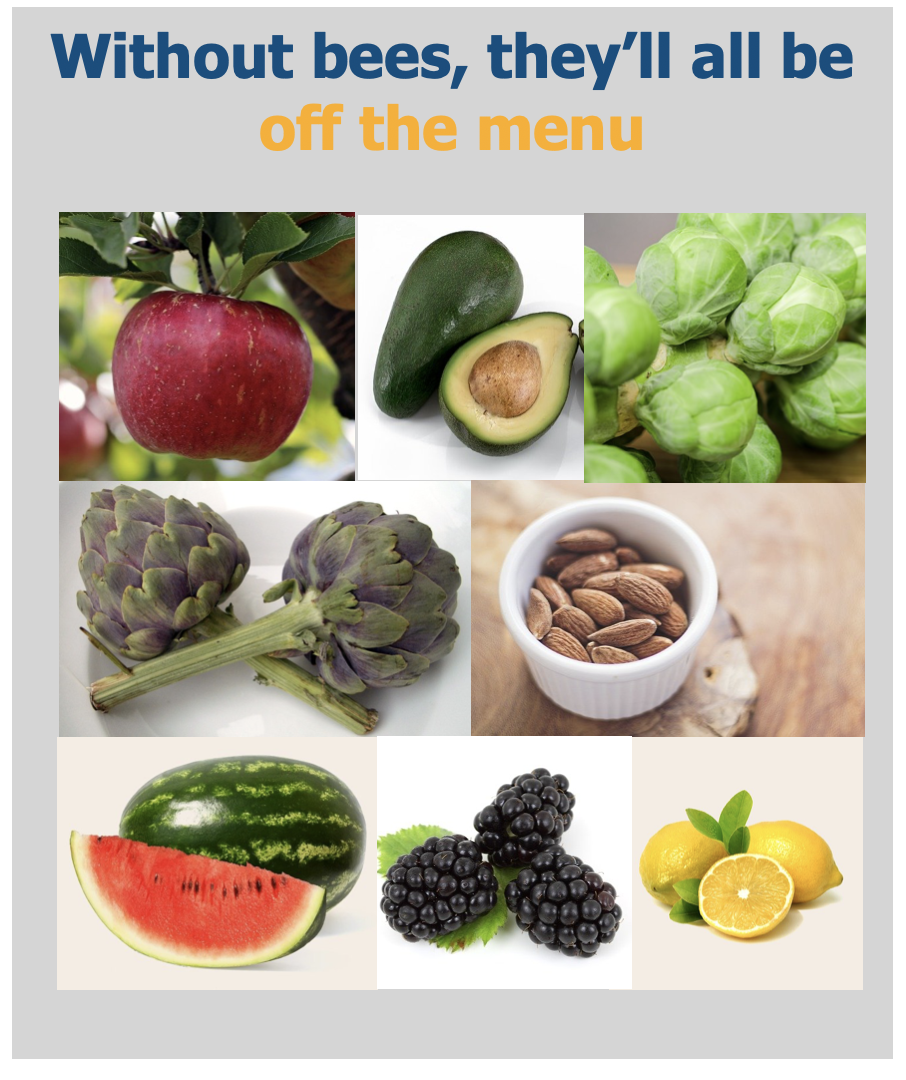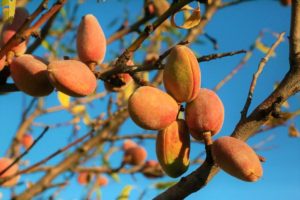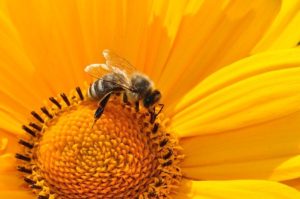 Do you ever feel under-appreciated?
Do you ever feel under-appreciated?
Whether you’re a mom who just finished a hectic week or an employee who just finished a big project, at times we have all had that feeling…“do they know how hard I work and what things would be like if I wasn’t here?”
Well, the bees may feel the same way!
Just in case you didn’t know, June 19-25 is National Pollinator Week, which is a week to recognize and learn more about pollinating animals such as bees, birds and butterflies, which are hugely important for our environment and food system.
In recognition of these under-appreciated pollinators, we wanted to shed some light on the “buzz” about bees, their recent decline, and why it matters! If you have kids, this is the kind of “birds and bees” that is MUCH easier to talk about!
Why are bees important?
Bees are so much more than a summertime nuisance — and it’s not just about the honey! Bees are an incredibly crucial part of our food system! Bees and other pollinators such as birds, bats, beetles and butterflies, are responsible for successful harvests of lots of fruits and vegetables — of the 100 crops that provide 90% of our food supply, almost 75% are bee-pollinated. This includes almonds, apples, asparagus, blueberries, broccoli, carrots, celery, cucumbers, grapes, nectarines, peanuts, squash, sunflowers and watermelons, just to name a few. Without bees, we wouldn’t have these foods!
So, how does it work?
 When bees are hungry, they visit flowers to eat. In the process, they transfer pollen and seeds from one flower to another, fertilizing the plant so it can grow and produce food. This cross-pollination helps at least 30% of the world’s crops thrive. Recent research has indicated that bees can be even more crucial to a successful harvest than fertilizer and water. A study out of the University of California, Berkley, found that an almond tree can deal with a lack of nutrients or water in the short-run (because of stored nutrients), but cannot compensate for lack of pollination.
When bees are hungry, they visit flowers to eat. In the process, they transfer pollen and seeds from one flower to another, fertilizing the plant so it can grow and produce food. This cross-pollination helps at least 30% of the world’s crops thrive. Recent research has indicated that bees can be even more crucial to a successful harvest than fertilizer and water. A study out of the University of California, Berkley, found that an almond tree can deal with a lack of nutrients or water in the short-run (because of stored nutrients), but cannot compensate for lack of pollination.
The most nutritious crops are the ones that rely most on pollination. For example, wheat, rice and corn are mostly pollinated by wind and are not as vulnerable to decreases in animal pollination. At the other end of the spectrum, almonds and blueberries will not produce any fruit without animal pollination. For other fruits and vegetables, animal pollination will result in more seeds, better germination…and higher quality fruit! Also, good animal pollination can reduce the time to go from flower to fruit, reducing the risk of adverse weather, disease, pests and other issues.
Why are bees on the decline?
In the U.S., more than 25% of the managed honeybee population has disappeared since 1990! Beekeepers have seen, over the past several years, beehive losses of 30% or more every year, which is much higher than normal. Earlier this year, for the first time in the U.S., a bumblebee species was placed on the federal endangered species list.
This decline, often called the Colony Collapse Disorder, is due to a combination of factors including 3 Ps: parasites, pathogens and pesticides. Just like humans, pesticides can also affect the health of bees, making them more vulnerable to infection and disease. Where pesticides are used, they can leave residue in the pollen, causing problems. As a result, Europe issued a partial ban on specific pesticides (known as neonicotinoids, or “neonics” for short) and the U.S. government continues to research whether these pesticides affect our pollinators and their decline. While some believe the pesticides are causing the decline in bee population, this has not been conclusively proven. Whatever the reason, the trends are definitely a cause for concern.
How does this affect us?
Imagine life without these pollinator-dependent fruits and vegetables (or life where these great foods are significantly more expensive). Unfortunately, fewer bees means less food production and a smaller diversity of plants.
Also, as the demand for fresh fruits and vegetables increases (which is always our hope!), this requires more bees to help increase the supply. Further declines in the bee population may prevent supply from keeping up with demand.
What can you do?
Since most of us are probably not interested in becoming backyard beekeepers, there are still things we can do to help with this situation:
 Plant nectar-rich plants (a bee-friendly garden), with lots and lots of flowers! Local garden centers can provide advice on “bee-friendly” options in your area.
Plant nectar-rich plants (a bee-friendly garden), with lots and lots of flowers! Local garden centers can provide advice on “bee-friendly” options in your area.- Stop and think before using pesticides! Consider other options.
- When you can, buy organic. This sends a vote that you want a cleaner food system for both your family and the bees. The more “votes” we all send, the more organic farming grows, and this may be the brightest hope for our future.
- Maintain birdbaths or other sources of water! Pollinators need fresh water too.
- Sponsor a hive! You may even get a free jar of honey!
- Support your local beekeepers!
- Spread the word! The more people aware of this threat, the higher the likelihood the trend can be reversed!
Finally, a little bit of trivia about bees:
 A colony of honey bees in the summer has about 50,000-60,000 bees.
A colony of honey bees in the summer has about 50,000-60,000 bees.- It takes about 30,000 bees to pollinate one acre of fruit trees.
- With its four wings and five eyes, the honey bee has an average life of six weeks during the working season. This brings new meaning to “working yourself to death!”
- An average honey bee only produces about 1/12th of a teaspoon of honey in its lifetime.
- A bee can visit 2,000 to 5,000 flowers in one single day.
- To make just one pound of honey, a hive of bees must travel over 55,000 miles and visit 2,000,000 flowers!
- Queen bees can lay as many as 2,000 eggs on a single day (that is about 1 every 45 seconds).
- A honey bee will rarely sting you unless it is stepped on or handled roughly. But if it does, it will die because it can’t pull its stinger back out and its abdominal area will rupture. If you do get stung, remove the stinger as soon as you can to minimize venom entering the skin. It’s best to scrape it out with your fingernail or a straight edged object (like a credit card). If you pull it out with tweezers or your fingers, you may inadvertently squeeze out more venom.
If you have any ideas others might be interested in (or just a good bee story), we would love to hear them!
 LEARN MORE ABOUT THE NAPKIN!
LEARN MORE ABOUT THE NAPKIN!


Leave A Comment